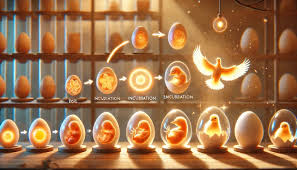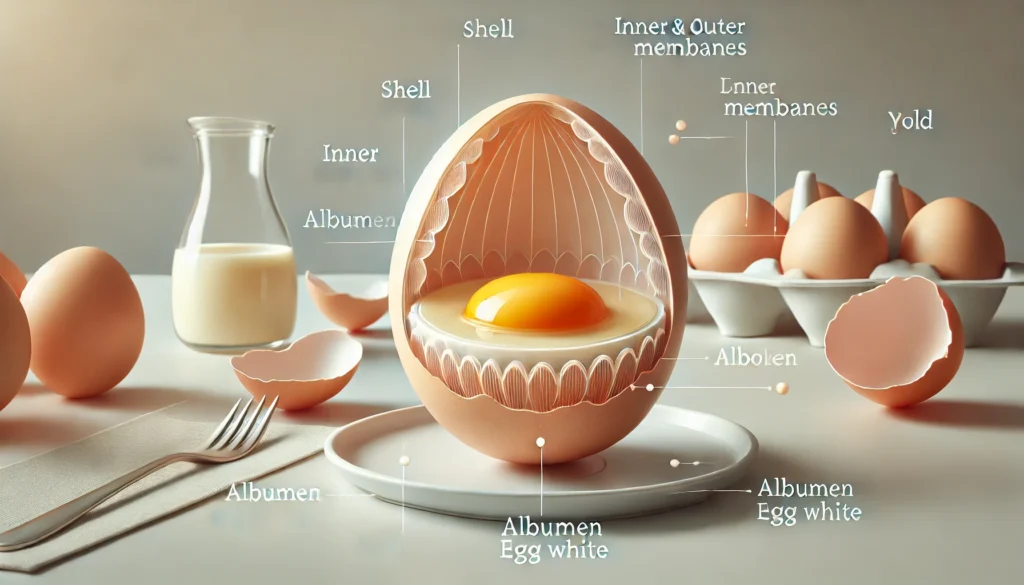Table of Contents
- Introduction to the Egg Deleup Process
- The History of Egg Preservation
- The Need for Innovation in Egg Preservation Methods
- How the Egg Deleup Process Works
- Benefits of Egg Deleup for Consumers and Producers
- Potential Impact on the Food Industry
- Challenges and Criticisms of the Egg Deleup Process
- Future Possibilities and Research on the Egg Deleup Process
- Conclusion: The Exciting Future
- FAQs:
Introduction to the Egg Deleup Process

Even in centuries long past when safety standards had not been established, the issue of preserving eggs was recognized as crucial. While this concern has not gone away, it does spawn new or refinements of existing techniques. Enter the Egg Deleup Process, which could amazingly change our relationship with eggs. This remarkable technology ensures improved nutrition and flavour while also extending storage duration. How does the research process work? This empirical compilation seeks to document the evolution of preserving eggs from ancient methods until today without leaving out modern methodologies that may have emerged.
The History of Egg Preservation
The beginnings of the preservation of chickens’ eggs go back many centuries. The need to use eggs due to their nutritional value led to the incentivization of techniques for prolonging the shelf life of eggs.
Dyeing or salting eggs was among the oldest practices aimed at loss mitigation. The Chinese skilfully developed the curing processes by producing boiled salted eggs as an exotic food.
However, as years passed, during the 19th century, freezing took over. This technological development enabled the change in the way food was stored, as well as how eggs and other vegetative foods that were easily spoiled were kept.
In remote areas, a typical practice they employed was the water glassing method, which involved dipping newly harvested eggs in a glass of sodium silicate solutions for storage during the offseason.
As the last decade of the twentieth century saw the introduction of complex businesses, the focus shifted towards adopting new methods that increased the storage capacity and ensured their freshness and quality. These pointed out the direction of modern means of preservation, which are being modified.
The Need for Innovation in Egg Preservation Methods
With the increase in worldwide appetite for eggs, traditional preservation methods are becoming ineffective. Shelf life techniques have a lot of shortfalls in terms of the fresh taste and nutritional content over time.
There are also increased consumer tendencies that require improvised ways; for this case, an egg refrigeration system can afford a good taste but becomes defective after a few weeks.
In addition to this, food wastage has become rampant and a global menace; billions of eggs get spoiled long before the buyer sits on the dining table. This affects the sales margin and hurts the region’s diversification efforts in great proportions.
In the bid to overcome such challenges, creativity should feature more prominently. With these new procedures, it is now possible to prolong the great taste and elements of egg nutrition well beyond the shelf life of many products. The future of the egg market is promising as several factors, such as the advancement of technology, allow for the reinvention of ways to store eggs.
How the Egg Deleup Process Works
The Egg Deleup procedure represents an essential concept for advancing egg sterilization technologies. The process starts with an elaborate selection of high-grade eggs so that only the top selection comes through.
The first step was to clean these eggs properly. This cleaning step was crucial in eliminating dirt particles and preparing the eggs for further treatment.
After this, what differentiates Deleup is the core technology, which is close vacuum technology. This provides for the overall sealing of every egg unit so that the air and bacteria present are reduced to the maximum possible.
The most critical development is followed. An application of dairy egg sets containing several natural compounds occurs at this stage. These compounds also can complement the vacuum seal in prolonging the egg’s shelf life while maintaining the egg’s nutritional and sensory characteristics.
The eggs that go through the processes above are packed and kept in thermoregulated rooms to achieve such temperatures. This ensures that the eggs complete the best characteristics until the eggs are in the consumers’ kitchensconsumers’ kitchens.
Benefits of Egg Deleup for Consumers and Producers
The egg development process has a lot of benefits for consumers and producers. For consumers, the major advantage is the extended shelf life of products. This implies that there are fresher eggs that can be kept for longer, thereby reducing the waste that is incurred in the households.
Producers can also benefit greatly, particularly from the increased efficiency elasticity of distribution and the possibility that the eggs can be transported over longer distances without losing quality. New markets and new avenues for expansion have been unlocked.
Furthermore, the consumers would always love the flavour as nutritional depletes in the otherwise begins and remains with the eggs till the end of their lifecycle. High-quality protein with essential nutrients is ideal as it is not damaged during the preparation or processing.
Man-savings are also appealing savings. Everybody’s buying price helps producers reduce spoilage rates, rationalize resources, and improve profits.
One of the advantages of using such an environmentally friendly solution within the Egg Deleup Process is that modern consumers are quite sensitive to such considerations, making it suitable for all age groups.
Potential Impact on the Food Industry
The Egg Deleup Process is said to change the food industry in multiple ways. Food waste can be reduced significantly with this process as it helps increase the shelf life of eggs. This innovation is being introduced when people are more concerned about sustainability than before.
Such consumers shall have ready access to more competitive products… and this may result in increased faith and allegiance to brands that use this method.
In addition, this method will decrease the spoilage and loss ratio, contributing to the inventory control more robustly and thus stimulating the Producers’ profitability. By minimizing the amount of losses, they can better use resource allocation.
With the growing emphasis on sustainable practices, companies employing the Egg Deleup Process could be in a better position relative to their target market. It may have ripple effects that can change not only the methods of storing eggs but also the ways of dealing with other food products with a limited storage life span in production worldwide.
Challenges and Criticisms of the Egg Deleup Process
The Egg Deleup Process appears to be ground-breaking; however, numerous drawbacks are associated. One such concern pertains to the presumable expenses in such an undertaking. Otherwise, these would exclude small-scale producers and consumers.
Another aspect that concerns potential distributors or consumers is that of marketing. The majority of people are used to certain practices related to egg preservation. Therefore, a new process will have to be practised and educated.
Another aspect that concerns distributors or marketers is regulatory policing. The food industry is a highly regulated sphere, and any advancement must be purposeful through the necessary hops to be approved.
There are some environmental issues, too. To prevent side effects, the egg development process’s agricultural supply must be carefully assessed for accessibility.
Some specialists believe that more studies on such aspects are warranted to determine possible long-term effects on the nutritional value of egg depletion. This controversy underscores the concern of remaining creative without overstepping the boundaries of what is considered safe in food technologies.
Future Possibilities and Research on the Egg Deleup Process
The egg development process has significant prospects for the future of food storage. Further work is directed toward optimal integration of this new technology to improve its effectiveness and cost.
Natural substances may be incorporated into the process as preservatives. These can be further affected by the taste and nutrition of the food. Nanotechnology is also a possibility where the specificity of the treatment of the eggs is concerned.
Consumer adaptability is also an area that is yet to be developed. Such an understanding would help to enhance or introduce more features that the customers need. Andrew would also support adopting the relevant practices by educating the consumers on the various advantages.
The most effective collaboration will be between researchers and industrial representatives in the quest for improvement and formulation of a gold standard. The connection between technology and sustainability should lead to further innovations in how egg storage and eating are integrated into people’s daily lives.
Conclusion: The Exciting Future
The first process to envision sealing the eggs for further use or storage is the Egg Deleup Process. Besides innovation and storage, it ensures that customers always have fresh goods domestically and elsewhere.
When people or consumers become ever more worried about the environment and sustainability, the Egg Deleup Process has been a problem solver for producers and waste concerns. It also saves both time and money by improving the management of resources in the egg supply chain while aiding in reducing wastage, which causes gaps in the supply chain.
In addition, other benefits may also be exposed as further research is carried out. The industry will likely grow as new technologies become available. Food safety and quality are important issues that should be closely monitored since they can change everything.
In looking forward to the future, accepting such changes will be important for achieving food security and sustainability as global challenges. The Egg Deleup Process solves the above concerns by merging the two aspects of innovation and technology.
FAQs:
What is the Egg Deleup Process?
The Egg Deleup Process is a cutting-edge technology that enhances egg preservation by extending shelf life and maintaining nutritional quality.
How does the Egg Deleup Process work?
The process involves vacuum sealing eggs and applying natural compounds to reduce air and bacteria, ensuring freshness and longevity.
Why is the Egg Deleup Process important?
It addresses food waste, improves egg quality, and supports sustainability in the food industry.
Can the Egg Deleup Process improve egg flavor?
The Egg Deleup Process helps retain eggs’ natural flavour and nutritional value throughout storage.
Is the Egg Deleup process environmentally friendly?
It promotes sustainability by reducing spoilage and optimizing egg production and storage resource use.
Who benefits from the Egg Deleup Process?
Both consumers and producers benefit through extended egg shelf life, reduced waste, and improved distribution efficiency.
What makes the Egg Deleup Process different from traditional methods?
Unlike traditional methods, the Egg Deleup Process uses advanced vacuum technology and natural compounds to enhance preservation.
How does the Egg Deleup Process reduce food waste?
Such a process reduces the amounts of spoilage and wastage during storage and transportation by increasing the storage times of the eggs.
Is the Egg Deleup Process cost-effective for producers?
Yes, it reduces spoilage rates, optimizes resource use, and opens opportunities for reaching distant markets.
What is the future of the Egg Deleup Process?
Ongoing research and innovation promise to further enhance the Egg Deleup process, making it more efficient and sustainable.

